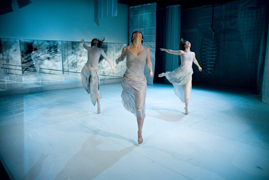A couple of comments linger long after watching the performance of Andrew de Lotbinère Harwood and Kirstie Simson, both accomplished dancer/improvisers. Prior to attending the concert, which occurred during the recent CORD (Congress on Research in Dance) conference in Montréal, one of the speakers, an academic from the United States, asked what was playing in town that night, and I mentioned the show at Studio 303. Her response was curt: “Oh, is [Harwood] still doing that?” That not-so-gentle put-down was countered by a woman who exited the show, remarking, “[Simson] has managed to take him far beyond what he normally does.”
The latter response is notable because it highlights the underlying tension in the evening’s work. Simson and Harwood have collaborated in performances and teaching workshops over the past quarter century. Their individual research goes years beyond that marker. In the press materials, the artists state: “Perhaps the real unique value of improvisation lies in its live spontaneity, its potential to discover something spectacularly dynamic, physical, and real by accident in the instant it is felt.” But how do plans and intentions intersect, and how can the improviser be open? Concentration, presence of mind and body, and the flow involved in collaboration are some of the key points in creating room for individual expression. The nature of that expression remained one of my queries for the evening.
We enter Studio 303’s warm, welcome space to the sound of howling wind. On a screen facing the audience is a video of mountains. Musician Diane Labrosse enters the wingless stage to sit at her turntables, which she plays live during the performance (somewhat later in the show, she also plays the accordion). She watches the cues of the dancers, and in places, prompts them. Simson and Harwood are rolling on the floor, first together — not in a huddle, but a gentle roll — then they roll apart. Both are clothed, both are barefoot. The lack of fanfare is refreshing: we see what we see. She has short blond hair; he’s bald. I notice feet and legs that seem to motivate gestures — arms that reach out, legs that stretch further. Harwood rolls into a modified shoulder stand.
On the screen, the camera zooms in on the mountains, slowly. Both Simson and Harwood retreat to the sides of the stage. Simson disappears. Harwood rolls on his side, up against the legs of the music table. The bare wood floor shimmers in the glow of the projected image. The projector shuts off.
Simson has reappeared and is now standing, moving gracefully, and it looks like she’s blowing, her arms lifted high. A cacophonous sound that Labrosse has created resonates, akin to crunching, cascading rocks. Simson’s eyes are open, almost staring, and there’s stillness to her movement. In her loose-fitting top and velour pants, she looks like a tai chi practitioner. We hear her individual story on the soundtrack that plays: “Ladies and gentlemen, my name is Kirstie. I was born in Nairobi. I am a modern nomad. I have no home. I travel all the time. I was born on June 9, 1958.” We hear sounds of birds and insects, nighttime sounds, and I imagine that she’s on a trek, her whole body animated. She looks out and up. If she’s dreaming of that place and time, we’re right there with her. On the tape, she’s telling stories of the Masai guarding her family. “Isn’t life amazing?” she comments on the audio as she retreats again into the shadows.
Then the sound of gravel overtakes the calm. Out of the dimness Harwood starts to jerk forward, on his side. His pelvis is motivating his movement. Soon he’s on one foot and knee; up and down he goes. He’s dressed in loose black trousers, an open red shirt and white t-shirt. The sound is rhythmic, thundering. The music fades, and the two dancers run from corner to corner, along the perimeters of the space. Labrosse, wearing a dress and shoes, straps on the accordion.
At this point, I’m watching Simson and Harwood and seeing difference. This is the first time I’ve seen Simson dance, and her luxurious fluid movements resonate with dramatic quality, accents of angularity and pauses that seem like sources of reconnection. Harwood, for his part, is a study in dynamic, bounding moves. He is intelligent and hardworking, but it is Simson who is the more generous of the two. If it is the idea of generosity that prompted the audience member’s earlier comment, the union of these two renowned performers still seems unbalanced. If Simson is awakening a generosity in Harwood’s performance or his stage persona not previously seen, then I’m not altogether privy to the results that the spectator saw in action.
At a certain moment, they come together head against head, weight against weight. Labrosse has moved back to her turntable and sound console. Bulls fight on screen in a longish sequence, and the scene between Simson and Harwood seems overly literal.
Shortly after the bullfighting sequence, the two dancers enter into a more active, energized shifting and sharing of weight. He plunges to the floor, hands first. She glides on her stomach, and seems entrancingly in her own world. For the audience, there’s nothing remote about watching her kinetic energy. The two circle and shadow each other, aware of the other, but not. At one point, Harwood walks over and grabs a spare seat cushion that the audience is not using, and throws it into the performing space. He stands it upright, places it between his legs and moves it across the stage. He eventually gets into a yoga-like child’s position. He then bolts into movement, a kind of skipping action. Then we hear his voice, telling us about his family: that he is one of seven children and that as a child he had relentless energy and a boundless sense of adventure. It seems that his story has been placed too far into the progression of the evening’s proceedings.
This performance revealed two movers, with technique and skill and craft, but essentially two people in pursuit of play. Awkwardness and grace intermingle. Innovators both, on this occasion it was more exciting seeing them move separately than on their journey together. Especially Simson. She has a most engaging way of fine-tuning our sensibilities. In the performance that I saw (another followed later that evening), their exchange in a moment-by-moment sense remained a challenge. Perhaps my expectations led me to hope for a connection that was more dynamic.
Tagged: Contemporary, Improvisation, Performance, Montréal , QC





